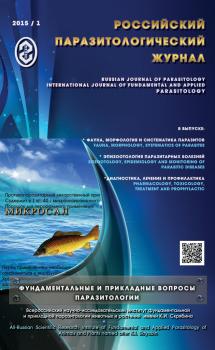Objective of research: The analysis of spatial distribution of ascariasis among the population in different regions of the republic of Belarus with respect to anthropological and cultural aspects. Investigations for regional differences in ascariasis conducted in the USSR were focused rather on climatic, hygienic and economic factors and didn’t consider the causative role of cultural and anthropological factors in epidemiological process. The study is aimed at correlation of regional indices of ascariasis with the previously defined spatial historical gradient manifested in Belarus. Materials and methods: The effect of social and cultural spatial gradient was assessed by comparison of difference in ascariasis morbidity between eastern and western regions of Belarus. Thus, the effect of ethnic and anthropological spatial gradient was considered in comparison of epidemiological indices between the Brest region (south-western part of Belarus) and Vitebsk region (north-eastern part). The analysis was conducted with the historical perspective; the regional epidemiological statistics were provided for two periods 1970-1989 and 2000-2014. Regional statistical materials of the republic of Belarus presented in the annual reports of the national Ministry of Health were used as an empirical basis. Results and discussion: The analysis showed, that the differentiation trend in distribution of ascariasis in Belarus correlates both with historical-cultural and anthropological spatial gradients. The identified pattern of regional differentiation allows to evaluate the complex effect of sociocultural and anthropogenic components on epidemiological features of ascariasis.
ascariasis incidence rate, ecological study, Belarus, eastern and western regions, Brest and Vitebsk regions.
Введение
Тезис о том, что географические особенности в распространении аскаридоза обусловлены сразу рядом разнообразных причин сегодня не вызывает возражений. Вопросы возникают, когда исследователь на конкретных примерах пытается определить доминирующиqмеханизм, ответственный за устойчивые различия в распространении этого заболевания, ли когда надо объяснить, отчего выраженные различия в заболеваемости существуют между соседними областями, районами, а иногда даже и между соседними деревнями [3, 10, 15].
Практически любой из показателей социальной и медико-биологической сферы полиэтиологический и интегральный по своей природе. При этом, в научной практике, комплексность в генезе формирования того или иного показателя, чаще, только постулируется, но не становится полноценным объектом исследования. Это в полной мере относится к проблемам анализа регионального распределения инфекционных и паразитарных заболеваний.
Неравномерность в заболеваемости аскаридозом на больших географических территориях преимущественно объяснялась особенностями климатических и геофизических условий, что касается, например, территории Российской Федерации или Украины [1-3]. Однако влияние внешней среды имеет более широкое значение, поскольку оно определяет способ хозяйствования и типы жилищного строительства, развитие и отраслевой характер животноводства, а также ряд других потенциальных эпидемиологических факторов. Иными словами, многие социокультурные и хозяйственные механизмы являются производными от действия геофизической среды, которая изначально определяет место человека в системе биогеоценоза. Эти же особенности географического пространства находят воплощение и в специфике культурной традиции отдельных регионов. Таким образом, можно говорить о прямом и опосредованном действии географического окружения на эпидемиологические характеристики аскаридоза, или об его интегральном эффекте. Разумеется, что указанная интегральность является методологическим препятствием для выделения эффекта обособленных этиологических механизмов.
1. Volosyuk V.P. К epidemiologii askaridoza v USSR i mery bor’by s nim na osnove ucheniya о mehanizme peredachi invazionnogo nachala. Aftoref. diss. kand.med. nauk [On epidemiology of ascariasis in USSR and measures for struggle against it, based on the learning about the invasion mechanism. Abst. PhD diss... med. sci.]. Kiev, 1969. 25 p. (In Russian)
2. Gritsay M.K., Bulgakov V.A., Ponomaryova V.E., Bolgarenko A.V. The prevalence of ascariasis and trichocephalosis in population of USSR. VIII Nauchnaya konferentsiya parazitologov Ukrainy [Proceedings of the VIIIth Scientific Conference of Parasitologists of the Ukrainian SSR]. Kiev, NIINTI, 1975, pp. 37-40 (In Russian)
3. Darchenkova N.N, Romanenko N.A., Chernyshenko A.I. Current situation on the prevalence of ascariasis in Russian Federation. Meditsinskaya parazitologiya i parazitarnye bolezni [Medical parasitology and parasitic diseases], 2006, no.4, pp. 40-42. (In Russian)
4. Kandrychyn S. Differentiation of the social space of Ukraine and Belarus due to the clash of civilizations]. Sotsiologiya: Teoriya, Metody, Marketing [Sociology: Theory, Methods, Marketing], 2008, no. 4, pp. 74-96. (In Russian)
5. Kandrychyn S. Resistance of population as psychosocial phenomenon. Example of incidence of upper respiratory infection in Belarus] Meditsinskie novosti [Medical news], 2014, no. 3, pp. 36-48. (In Russian)
6. Kandrychyn S. Brest and Vitebsk regions as two opposite poles of the mental space of Belarus. Psichiatriya, psichoterapiya i klinicheskaya psichologiya [Psychiatry, psychotherapy and clinical psychology], 2012, no. l, pp. 112-144. (In Russian)
7. Main health indicators of population, activity of sanitary-epidemiological service and environmental condition. GU Respublikanskiy centr gigieny, epidemiologii i obshhestvennogo zdorov’ya. Ministerstvo Zdravoohranenija Respubliki Belarus’ [Centre for Hygiene, Epidemiology and Public Health of the Republic of Belarus. Ministry of Health of the Republic of Belarus. Annual edition]. Minsk (In Russian)
8. Tegako L.I., Salivon I.I. Osnovy antropologii i ekologii cheloveka [Essentials of anthropology and human ecology]. Minsk, Technologiya, 1997. 328 p. (In Russian)
9. Chistenko, G.N., Bekish V.Ya. The epidemiological and geographical aspects of ascariases. Zdravoohranenie [Healthcare], 1997, no. 2, pp. 38-40.
10. Kandrycyn, S. Geografia spoleczna i kontury historii: Podzialy historyczne Bialorusi w swietle danych statystyki spolecznej, medycznej i demograficznej. Warszawa, Semper, 2008. 178 p. (in Polish)
11. Karan A, Chapman G.B., Galvani A. The Influence of Poverty and Culture on the Transmission of Parasitic Infections in Rural Nicaraguan Villages. J Parasitol Res., 2012, vol. 2012.
12. Morgenstern H. Ecologic studies in epidemiology: concepts, principles, and methods. Ann Rev Public Health, 1995, vol. 16, pp. 61-81.
13. Scholtea R.G.C., Freitas C.C., Dutrac L.V., et. al. Utilizing environmental, socioeconomic data and GIS techniques to estimate the risk for ascariasis and trichuriasis in Minas Gerais, Brazil. Acta Tropica, 2012, vol. 121, pp. 112-117.
14. Scott M. E. Ascaris lumbricoides: A Review of Its Epidemiology and Relationship to Other Infections. Ann Nestle, 2008, vol. 66, pp. 7-22.
15. Wakefield J. Ecologic studies revisited. Annu Rev Public Health, 2008, vol. 29, pp. 75-90.





